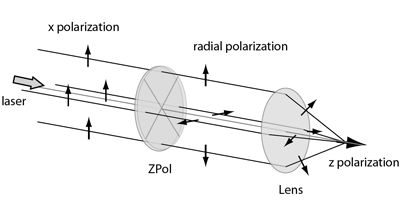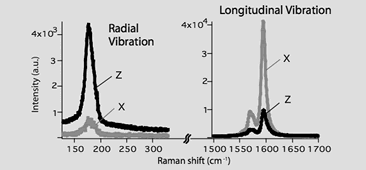
Create a “polarization Z” light which vibrates in the direction of light propagation. Exhibits its power in three-dimensional measurement of the orientation of the crystal and molecular. ZPol produces a “polarizing z” light that vibrates in the direction (z) of the light traveling direction. Y-polarized light shear wave, polarized light and x, tempting to think light is not polarized in z. However, the three-dimensional space exist naturally polarized in the z direction. Nanophoton’s ZPol, easily create z polarization, which had been forgotten until now. ZPol makes it possible to measure in three dimensions x and y and z orientation of the crystals and molecules.
Z polarizer(Radial polarizer) Achieved to drastically reduce of price of ZPol!
We have a price reduction to 280,000 yen for the element of quad 532nm and 785nm center wavelength due to a significant reduction in manufacturing costs by reviewing manufacturing methods of Z polarizer (Radial polarizer). Please consider your purchase means on this occasion.
How to use
The incident Zpol linearly polarized light can be radially polarized light, and lens to its radial polarized light. It can produce a field of the light beam has an angular dispersion by each condenser lens with a large electric field component in the z-direction by their interference. It can be made even azimuthal polarization by choice, it is possible to produce a light collecting field that the z component of the electric field to zero in this case.

Wavelength
Standard wavelength: 532nm and 785nm(In other wavelenghth, contact us.)
Also available in ultra-short femtosecond laser pulse.
Example of use
The following illustration is an example of applying the ZPol to measure Raman scattering of carbon nanotubes. It is the result of the measurement by switching the x polarization and z polarized light using ZPol. It is found that high sensitivity is measured by polarization z (vibration in the direction perpendicular to the axis of the tube) breathing vibration of the nanotubes located on the axis x.

▲Tip enhanced raman spectrum of carbon nanotubes. Specific Raman peaks are selectively observed by changing z polarized light and x polarized light by using ZPol. Y. Saito et al., Chem. Phys. Lett. 410, 136 (2005).)(RIKEN)
Specifications
| Center wavelength | selectable |
| Transmittance at center wavelength | more than 95% |
| Retardation accuracy | ±0.05λ at center wavelength |
| Axis orientation accuracy of the wave plate | ±2° |
| Effective diameter | 10mm |
| Holder outer diameter | 25mm |
FAQ
What is the usable wavelength range?
The available bandwidth of ZPol is as follows.
- Multi-order wave plate (standard product): Center wavelength ± 0.5%
- Zero order wavelength plate (special order item): Center wavelength ± 4%
How much is the damage threshold?
If the element surface is clean, it can be used empirically up to 10W / cm2 with CW. It is recommended to use a high-power compatible model (custom-made product) that does not use an adhesive, as the adhesive may burn if used for higher intensity lasers. If it is a high power compatible model, it can be used by CW up to 1000W / cm2. However, the damage threshold is not a guaranteed value because the laser resistance of the device largely depends on the operating conditions such as the operating environment and the surface condition of the device.
Is it possible to use even a pulsed laser?
If the pulse width is 5 ps or more, a multi-order wave plate (standard product) can be used. When using a femtosecond pulse laser, use a zero-order wave plate (custom-made product) because the wavelength of the laser is wide. In the case of a commonly used titanium-sapphire laser (typically 800 nm, 100 fs, 80 MHz, 1 W on average), the adhesive may be burned if it is directly incident on ZPol, so high-power handling without using an adhesive is possible. Models (special order items) are recommended.
What is the polarization direction of the four polarization elements in the product?
The axis orientation of each of the four wave plates is as shown below. A linearly polarized laser beam produces a radially polarized beam.

What is the optical property of the part where polarizing elements are joined?
The junction is a clear adhesive. The adhesive is isotropic and has a maximum thickness of 100 μm. Also, the use of joints is not disclosed.
How do we introduce a laser?
In order to avoid the influence of the junction, it is recommended that the beam diameter be expanded as much as possible and the beam be incident on ZPol.
What is the allowable angle of element tilt with respect to the optical axis?
Although there is no evaluation data, as a matter of experience, the incident angle should be approximately 0 degrees.
What is the allowable position accuracy of the division center of the element and the optical axis center?
Although there is no evaluation data, from experience, the allowable position accuracy for the optical axis center is approximately ± 0.1 mm.
What is the ideal usage environment (combination of optics etc.)?
In order to produce Z-polarization, a collimated linearly polarized laser beam is vertically incident on the surface of the element at the center of the element, and the light transmitted through the element is collected by a lens. Since the intensity of the Z-polarization generated is proportional to the fourth power of the lens used for focusing, we recommend using a lens with a large NA. Ideally, the light transmitted through the element is collected directly by a lens without being reflected by a mirror or the like. In the case of reflection by mirrors, it is ideal to use a special mirror that does not cause a phase difference with respect to P-polarization and S-polarization components of incident light (we do not handle such mirrors. Please consult the manufacturer of the optical mirror).
What material is using?
The material of ZPol is artificial quartz (crystal of quartz (SiO2) grown by hydrothermal method).
What is the difference between 4 and 8 divisions?
The intensity of the z-polarization generated by the 8-split is about 15% higher.
How is the retardation guaranteed?
The birefringence of high quality artificial crystals almost matches the literature values regardless of the lot. Therefore, the retardation is guaranteed by measuring the thickness of the wave plate, determining the retardation from the birefringence value of the literature value and the measured thickness, and confirming that this is within the tolerance.
How to remove dirt such as fingerprints?
After removing dust with a blower, wipe the swab with isopropyl alcohol or acetone. Rubbing it hard will scratch it, so wipe it gently. Wipe out from the center in a swirling manner. If you can not get rid of it once, do not use the same swab twice and use a new one (do not use twice with the same swab). The solvent is recommended for reagents. Make sure that the solvent evaporates immediately.
How to easily confirm that Z polarization is generated?
It’s not easy, but you can check it in two ways:
- When the metal-plated AFM tip is brought close, the Z-polarization component is strongly scattered, so the distribution can be examined.
- It is embedded in a Raman microscope, and a Raman tensor such as alpha quartz can measure a known sample and judge it from the result.